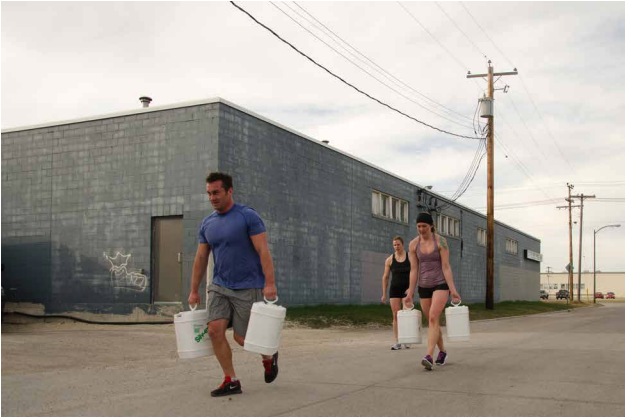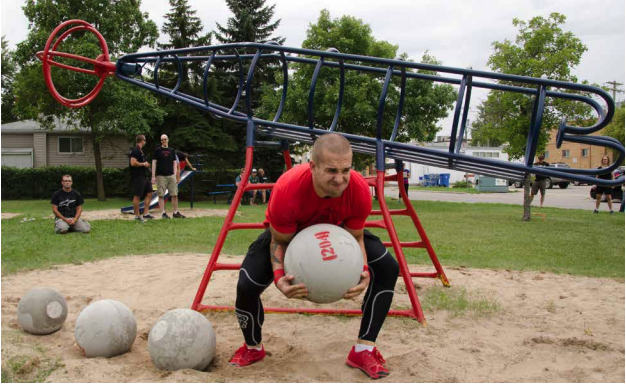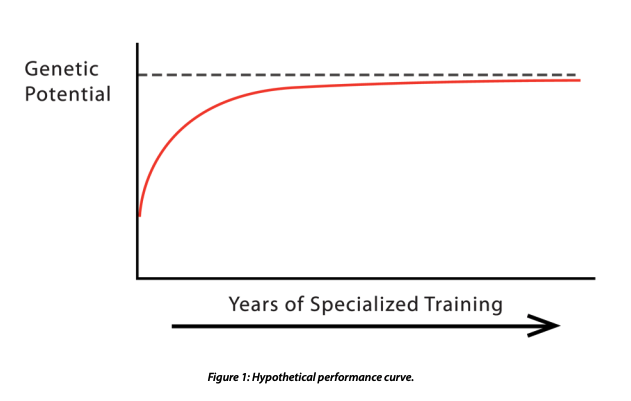These are exciting times for the avid CrossFitter. The success of the CrossFit Games comes in part because humans are competitive by nature. Our ancestors had to be competitive to survive. Therefore, it is only natural that when confronted with a new sport or challenge, many of us rise to the occasion and try to excel.
CrossFit has struck a chord with thousands of athletes worldwide, and it has sparked the interest of athletes who see potential for it to be a semi-professional and even a full professional sport.
I believe the continued growth of the Games, the Reebok sponsorship and the television advertisements have sparked the interest of thousands and thousands of people. Basically, more people will be introduced to a fantastic way of training because of this growth. However, a potential negative aspect of advertisements and Games success is that many will incorrectly view CrossFit as too intense, beyond their capability and as a sport for elite athletes.
I have written this article to provide some basic ammunition to convince people otherwise.
We all know this important quote from the CrossFit.com “What is CrossFit?” page: “Our program delivers a fitness that is, by design, broad, general, and inclusive. Our specialty is not specializing. Combat, survival, many sports, and life reward this kind of fitness and, on average, punish the specialist.”
The word “inclusive” is a key component of this sentence.
Put simplistically, as the understanding of CrossFit grows, two large groups of people will view CrossFit as either beyond their capability and/or not relevant to their training needs. One group comprises competitive athletes who think CrossFit workouts are not relevant to their sport. The second and larger group comprises those looking for general fitness, those who are by nature not competitive and those who believe the general misconception that aerobic conditioning is all they need. I propose that these two groups may be difficult for affiliate owners to connect with despite the increased publicity.
I will discuss the benefit of CrossFit training for these two groups somewhat separately despite the obvious fact that the topics I discuss are relevant to both groups. I will make no apologies that this article has a little more personal and anecdotal information than many of my previous exercise-physiology-based articles. One reason for this is that the research in the area of fitness has largely ignored one major benefit of CrossFit training: transfer of training.

Athletes and General Physical Preparedness
As stated, many athletes look at CrossFit’s “our specialty is not specializing“ quote and think the program is unsuitable for athletes specializing in another sport. This is far from the truth. Building a strong work capacity across broad time and modal domains will help all athletes achieve their goals. For non-competitive persons, this broad and general fitness will clearly help them perform their daily activities more easily and reduce injuries. This concept of needing a base of fitness, a non-specialized training program, is often referred to as general physical preparedness (GPP).
This is what Coach Greg Glassman once wrote about GPP on the CrossFit Message Board:
- GPP is the most underdeveloped and neglected aspect of athletic training, especially in elite athletes.
- CrossFit produces an unmatched GPP in novice, intermediate, and advanced athletes regardless of their prior training and sport.
- Every athlete we’ve worked with, from Olympic medalists to UFC legends, has some glaring chink in his/her GPP, and it takes at most two hours, two sessions, on average to find these chinks.
- Fixing these chinks, these deficiencies, has an immediate benefit within your sport and very often in ways not quite obvious mechanically and perhaps metabolically. For instance, more pull-ups make for better skiing and skiers. Upper-body pushing movements make for better rowing and rowers. Anaerobic training is a boon to endurance athletes.
- There’s greater margin for improving performance in elite athletes by improving GPP with CrossFit than can be garnered through additional sport-specific training.
- “CrossFit produces a ‘ready state’ from which more advanced or sport-specific training becomes very efficient.” —Mark Twight
- CrossFit will for many sports reduce the total training volume, reduce training injuries, and allow more time for vital sport specific skills and drills.
- CrossFit is more fun and seems more athletic to experienced athletes than does traditional GPP.
- CrossFit has athletes improving their fitness for years beyond, to levels significantly beyond, traditional GPP.
- Sport training and physiology are not so well understood that highly specialized strength and conditioning routines are optimally effective.
There is a lot of truth in these statements that many experts who are not involved with CrossFit would support. For example, in 2009 I attended the annual conference of the Canadian Society of Exercise Physiologists and attended a talk on “Philosophy of Training” by Dr. Jay Kearney. Kearney, a 1980 Olympian, returned to the United States Olympic Committee in December 2006. Kearney had previously served the organization for 14 years as a sports physiologist in the Sport Science Division from 1986 to 2000. His expertise was accumulated in a 30-plusyear career focused primarily on optimization of elite-level athletic performance. During this time he has been at 14 Olympics, coached and competed at the international level, and served the needs of coaches and athletes.
Kearney’s talk was a presentation of a series of observations over his career that he called his “tenets of training”. I will not repeat all of them here, as some were basic principles that I have discussed in my July 2007 CrossFit Journal article Principles of Physiologic Conditioning. However, I have listed several of his observations below that mesh perfectly with those aspects of CrossFit philosophy that all athletes need to understand:
- Athletes tend to do, or prefer most, that type of training they need the least.
- It takes a larger foundation to build a church than it does to build an outhouse.
- Elite athletes are not grown-up college sophomores.
- Transfer of training adaptation is a vastly underappreciated concept and has been largely ignored in research literature.
I will briefly discuss these four tenets even though some are well understood by the CrossFit community.
We all know that we need to work on our weaknesses, but we equally know that without a coach to push us, we are very good at avoiding our weaknesses. We all like to do what we’re good at, but that will not fix deficiencies in our fitness armor. Do I really “want” to do overhead squats? Do I really “need” to do overhead squats?
I am not just a “CrossFitter” in the sense that it is my only sport or exercise regime. I am a competitive tennis player, and I ski a lot during the season. I only recently hung up the soccer boots after playing at the competitive masters level. I’ll be honest: if somebody calls for me a tennis game when I was considering doing Fran, the answer will be, “What time shall we meet at the court?” I love sports, I love chasing tennis/soccer/rugby/squash balls, and I love beating people. Having said that, CrossFit is my GPP program; it improves my ability in sport and in life.
When an affiliate owner is trying to convince an athlete to start CrossFit, the athlete often finds it hard to believe that most research has largely ignored GPP. Coach Glassman’s statement above is, “GPP is the most underdeveloped and neglected aspect of athletic training, especially in elite athletes.”

Dr. Kearney concurs with the statement, “Transfer of training adaptation is a vastly underappreciated concept and has been largely ignored in research literature.”
The question many of my students ask is “how can that be?” The answer is quite simple. How can I prove having more pull-ups will improve the performance of the soccer players I coach? I can do a study to show this or that particular training regime will improve pull-ups, but being better at a sport is impossible to directly measure due to the myriad variables that are relevant to sport success. So the simple truth is researchers have largely ignored transfer of training or have measured narrow aspects of this phenomenon.
For example, I can easily do a study to show weight training improves an athlete’s tennis-serve velocity as that is a single, easily measureable variable. However, the fact that CrossFit trains so many aspects of physical performance required by a tennis player means it is difficult to truly “prove” the outstanding GPP delivered by CrossFit will make you a better tennis player. We all know that with CrossFit the whole is greater than the sum of the parts, and this, too, is hard to study.
I am not saying that being an elite athlete in a particular sport does not take considerable specialized training. What I am saying is that outstanding GPP will make you a better athlete. The wonderful aspects of CrossFit Football, CrossFit Endurance and other CrossFit programs is that they realize the benefit of outstanding GPP: they are trying to specialize their athletes from a big foundation (building a church not an outhouse).
Another aspect of the research that has confused the study of human performance is that many studies have not used committed and skilled athletes. As Kearney puts it, “Elite athletes are not grown-up college sophomores.” Beware of research conducted on college students and that claims to be relevant to elite athletes, Marines, firefighters or anyone who isn’t a college student.
If you look at elite CrossFit athletes training, it’s clear that the amazing physiological response to CrossFit programming is enhanced due to the psychological drive and commitment required to perform the WODs. You can get huge fitness improvements in a sedentary individual with a pretty average training regime, and for this reason the research is littered with studies showing mediocre programs getting results. As Coach Glassman’s ninth point above states, CrossFit coaches have observed already very fit athletes increasing fitness levels for many years when following CrossFit programming. Even at the age of 56, I have found some aspects of my fitness have improved over the six years I have been doing CrossFit programming, while other components in which I was already very conditioned have hardly suffered by less specialization.
General Population and General Physical Preparedness
I think the above discussion is a strong argument for athletes not to over-specialize and to pay attention to GPP. Therefore, I think it goes without saying that the rest of us should focus on GPP. If you are not a specialized athlete, your training should be aimed at keeping you healthy and prepared for the variety of challenges life will often throw at you. Unfortunately, many individuals with no aspirations to be competitive athletes train only in one or two physical skill areas and only in the oxidative energy system. Hence, they become specialized without intending to. Many others just lift weights and are only fit to lift weights. The net result is that many of the exercising public totally ignore, or are unaware of, the need for GPP.
A strong argument to make when suggesting a non-athlete try CrossFit is that there are diminishing returns when you keep doing the same thing over and over. Figure 1 is a simplified version of a graph Mark Rippetoe presented in his September 2007 CrossFit Journal article Strong Enough? This is a hypothetical graph showing how athletes progress toward their genetic potential in any given activity. I say “hypothetical” because, although we know the general shape of such curves, we cannot claim to know the exact steepness of the curve related to training years. However, I believe the curve should convey the basic concept—fast progress early in training as a novice, and increasingly slower progress as you improve toward an elite performance level (in fact, any progress is hard to achieve at the elite level).
Figure 1 could represent any activity. The Y-axis could be your genetic potential for the press or your 10-kilometer run time. You could draw literally an infinite number of these curves for any activity and power output. However, it is not possible get very close to the limit of your genetic potential in all of these activities. Nobody can run a 2.5-hour marathon and deadlift 700 lb. It is simply not possible to get really close to your genetic potential in such vastly different events for several reasons:
- Long-distance aerobic work, like marathons and other endurance workouts, may catabolize some muscles and would therefore be detrimental to someone wanting to be as strong as possible. You literally use some of your muscle for fuel during really long endurance events.
- Building upper-body musculature is going to add weight, and moving that weight around the track or over a mountain is going to be harder and will slow you down. Alberto Contador, the winner of the 2007 and 2009 Tour de France, was at that time 5-foot-9 and 135 lb.—great statistics for getting over mountains, but don’t ask him what weights he uses for deadlifts or back squats! Having said that, even cyclists climbing mountains can benefit from a good GPP base.
- At the cellular level, concentrations of aerobic and anaerobic enzymes cannot both be maximized.
- Training some energy systems and some muscle groups detracts from training others. There aren’t enough hours in the day to maximize everything, and even if there were, your body would be too fatigued to continue training.

I am simply stating that you will not be close to your genetic potential in any specific activity if you embrace CrossFit. That may sound like a negative comment, but it isn’t. Although we can be rightly amazed at the genetic potential of the very best, these performances come at a huge price. For example, the world record for the 10-kilometer on the track is 26:17.53 (the female world record is 29:31.78). Can you imagine what these individuals can clean and jerk? Some humans can bench more than 1,000 lb. (not without a crazy bench-press suit, but that is another story), but moving their body weight over distance would be virtually beyond them. I could go on, but you get the picture.
The media currently plays up the top mode-/intensity-specific athlete, and it will be interesting to see if there is any shift in this love affair with specialization as CrossFit gains further popularity.
If you look at the curve in Figure 1, you can probably figure out that it is possible to get to a reasonable level in lots of things. The curve rises steeply when you first start activities, so if you start a new activity, you will see progress quickly. I think this is part of the reason CrossFit has been very well received and has grown rapidly— people see great improvements in many areas. Is this a trick? I do not believe so. CrossFit is simply a program that effectively says, “Rather than run and run and run and see little further improvement, why not run some days (and maintain a decent level of running) but spend more time doing other things?”
For the general public I would ask, “What would you want: 80 percent of your genetic potential in strength, speed and endurance or 95 percent of your genetic potential in endurance but only 50 percent of your genetic potential in strength and speed?” I only use those percentages to illustrate the concept; nobody can really put a definitive figure on what is achievable. The answer depends on the individual and his or her training intensity and variety. However, many top-level CrossFit athletes might be able to run 10 kilometers in 40 minutes and deadlift 500 lb. That’s an impressive combination, and although neither score for that event is anywhere near world class, that type of individual would make a better Marine or firefighter than someone with a 35-minute 10K and a 200-lb. deadlift.
Obviously I could write at length on the specific benefits of CrossFit for the general public, but I and many others have discussed specific examples in numerous articles. For example, in my March 2007 CrossFit Journal article Performance and Health, I specifically discussed the benefit of CrossFit training in maintaining back health and reducing the incidence of slips and falls. So I will finish this article by just mentioning another major misconception preventing many from starting CrossFit: the intensity of the WODs. To this complaint I have two major responses.
The first is to tell the potential CrossFitter not to shoot the messenger. We didn’t create our DNA; nature did that. Per-Olof Astrand (M.D., Ph.D.) is a world-renowned exercise physiologist, and in his authoritative Textbook of Work Physiology (Åstrand and Rodahl, 1970), he states that “close to 100% of the biologic existence of humans was adapted to an outdoor existence of hunting and foraging for foods.” He noted major adaptations for human survival “were consistent with habitual physical activity, including endurance and peak effort alternated with rest.” So peak efforts are in our DNA. If you can’t think of a situation where you might have to perform a short, maximal sprint or exert a large force, you have a great—but naïve—outlook on life.
Another point I make is that even starting CrossFit at a low intensity and reducing the measured aspect because the client isn’t competitive is still a great first step. As an example, even a relatively light overhead squat is going to improve balance, core endurance and flexibility. The CrossFit magic is in the types and variety of movements and the varied intensity. But even if a client only taps into part of that magic, he or she is still going to benefit greatly compared to doing the same thing over and over again.
The bottom line: Ignore GPP at your peril.